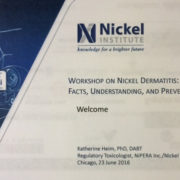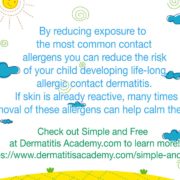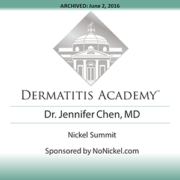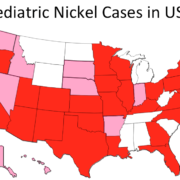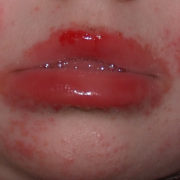Test your Paraphenylediamine (PPD) Savvy
/in Allergic Contact Dermatitis Facts, Allergic Contact Dermatitis Information/by Sharon Jacob MDFibroblasts and oral-induced tolerance against nickel…
/in Allergic Contact Dermatitis Facts, Nickel Contact Dermatitis/by Sharon Jacob MD‘Differences in human gingival and dermal fibroblasts may contribute to oral-induced tolerance against nickel’…
present results unveil new aspects of oral-induced tolerance and provide additional information for current knowledge, which indicates that oral Ni2 challenge before piercings may prevent Ni hypersensitivity…
Read more here:http://www.ncbi.nlm.nih.gov/pubmed/27264456
Nickel Workshop
/in Allergic Contact Dermatitis Facts, Regulation and Policy/by Sharon Jacob MDOn June 23, 2016, a historic event occurred – the first US Nickel Workshop. Thought leaders from medicine, industry and regulation came together to discuss the issue of nickel dermatitis, appropriate uses of nickel, and the integral role of nickel in society at the first North American Workshop on Nickel Dermatitis. This workshop was sponsored and coordinated by the Nickel Institute, who brought toxicologists and dermatologists together with conscientious companies representing various consumer product sectors. The group stressed the importance of nickel release, not nickel content in determining risk of becoming allergic to nickel and having a nickel dermatitis reaction if you are already allergic to nickel.
Removing nickel from our environment is not possible, because it is one of the most abundant metals on our planet and it has many beneficial uses where it cannot be reasonably substituted (e.g. stainless steel) . What is possible, though, is to use it in the safest ways possible. For example, nickel is safely used in several types of stainless steels. Nickel is also used as nickel-plated carbon fibers in the composite case of personal cell phones to keep our brains safe from the electromagnetic energy generated from by cell phone use. A top priority was discussed at the nickel workshop of removing high nickel-release materials from use in piercing posts (used in jewelry) by using appropriate low nickel-releasing materials (e.g. surgical stainless steel, high quality gold, etc.) since piercing directly introduces releasednickel to an open wound. This is especially important for children who, if sensitized, have a lifetime to deal with the consequences.
The Nickel Institute will be putting together a full report from the Nickel Workshop, which will be made available online on the Nickel Institute website at https://www.nickelinstitute.org Dr. Jennifer Chen, MD, a dermatologist from Stanford University, presented the background of nickel allergy in the US at the Nickel Workshop in addition to developing an outreach education webinar on this topic available to the public https://www.dermatitisacademy.com/webinars/ The webinar discusses that EU regulations have decreased nickel allergy in ear pierced young women from 16.6% down to 6.9%. The estimated savings of $2 billion over the last 20 years is massive and that could translate into an even bigger savings with the US population.
At the Nickel Workshop, Dr. Sharon Jacob, MD, a dermatologist from Loma Linda presented the situation of nickel dermatitis in children in North America, noting that nickel allergy is found at an early age and is thought to be largely due to ear piercing in young girls. She reported that an estimated 11% of the US general population is currently sensitized to nickel, which includes an estimated 8,133,603 children! She also stated that a significant proportion of these could be prevented by utilizing safer metals in piercing. Dr. Jacob ended her presentation at the Nickel Workshop with a slide that said:
‘You can’t tell an adult they can’t pierce and smoke… but you can protect a child.’
To learn more about nickel allergy and sensitization, please visit the Dermatitis Academy page dedicated to nickel https://www.dermatitisacademy.com/nickel-page/ which includes information on the low nickel diet, how to DMG test metal objects to screen for nickel release, a quiz on sources of nickel and a general population questionnaire on nickel sensitization. https://emg.wufoo.com/forms/nickel-allergic-contact-dermatitis-survey/
Test your cobalt savvy
/1 Comment/in Allergic Contact Dermatitis Facts, Allergic Contact Dermatitis Information/by Sharon Jacob MDSimple & Free
/in Allergic Contact Dermatitis Facts, Allergic Contact Dermatitis Information/by Sharon Jacob MDSimple & Free
By Hannah Hill, MD and Sharon E. Jacob, MD
It is time to be Simple & Free! Pediatric allergic contact dermatitis (ACD) has been increasingly recognized in the United States over the last decade. Reported rates of positive patch tests in children referred for suspected ACD range between 27% and 95.6%. Many young children are becoming sensitized to contact allergens found in personal hygiene products such as cleansers, moisturizers, sunscreens and topical medications like steroids and antibiotic ointments. Dr. Jacob and her team have been promoting pre-emptive avoidance strategy (P.E.A.S.) since 2005, especially in patients with widespread dermatitis, and seeing a remarkable impact. This led to the team developing the Simple & Free guideline, making P.E.A.S publicly available, with the goal of reducing skin rashes (dermatitis) associated with the top sensitizing allergens and potentially a decrease in sensitization.
With the goal of identifying the top allergens responsible for a significant portion of pediatric ACD caused by personal hygiene products, Hill et al. reviewed five recent pediatric patch test studies. The top ten allergens identified by this meta-analysis of the US pediatric patch test were neomycin, balsam of Peru (a screening substance for fragrance allergy), fragrance mix, lanolin, cocamidopropylbetaine, formaldehyde, corticosteroids, methylchlorisothiazolinone (MCI)/methylisothiazolinone (MI), propylene glycol, and benzalkonium chloride. Upon review of the included studies it was also estimated that between one quarter and one third of children suffering from ACD could potentially benefit from a “pre-emptive avoidance strategy” (P.E.A.S.) of the stated top 10 allergens! Dermatitis Academy then created the Simple & Free guideline to highlight the products devoid of the top 10 sensitizers. Given that benzalkonium chloride (BAC) is a very rare allergen and well known irritant, the high reporting from one study in the meta-analysis likely represents irritant reactions being read as allergens. For this reason BAC was replaced by para-phenylenediamine, a Consumer Patient Safety Commission (CPSC) designated ‘Strong Sensitizer’, in Dermatitis Academy’s top 10 sensitizers to be pre-emptively avoided.
http://www.ncbi.nlm.nih.gov/pubmed/22828255
http://www.ncbi.nlm.nih.gov/pubmed/18503686
By utilizing resources that identify consumer products for the presence, or lack of, specific contact allergens, consumers can use the pre-emptive avoidance strategy to select Simple & Free formulations and potentially prevent the development of, or remit ACD. Patients most likely to benefit from these efforts include those with eczema, sensitive skin, known allergy, or family history of inflammatory skin diseases. This article briefly shows examples of products devoid of the top allergens, but consumers are encouraged to utilize Dermatitis Academy’s Simple & Free guideline, which utilizes the pre-emptive avoidance strategy P.E.A.S. to highlight products that are both Simple in their formulation and Free of the top 10 P.E.A.S. identified sensitizing allergens.
Article:Hill H, Goldenberg A, Golkar L, Beck K, Williams J, and Jacob SE. Pre-Emptive Avoidance Strategy (P.E.A.S.) – addressing allergic contact dermatitis in pediatric populations. Expert Review of Clinical Immunology. 2016 Jan http://www.ncbi.nlm.nih.gov/pubmed/?term=P.E.A.S.
Nickel Contact Dermatitis Summit Webinar
/7 Comments/in Allergic Contact Dermatitis Facts, Nickel Contact Dermatitis/by Sharon Jacob MDNickel Contact Dermatitis Summit
For 53 years, nickel has been unparalleled as the most common allergen documented in patch-tested patients of all ages worldwide, which we call attention to as the Nickel Contact Dermatitis Summit approaches. And yet, nickel sensitivity is a much wider problem than the documentation suggests, as Peltonen alarmingly and poignantly pointed out over 30 years ago: “half of the subjects sensitized to nickel have never consulted a doctor because of their nickel dermatitis; still fewer have visited a dermatologist”. In the US we are in the midst of a prospering hidden nickel epidemic akin to that seen in Europe prior to nickel regulation legislation. There are millions of adults and children sensitized each year – the rates are UNACCEPTABLE, because this is a PREVENTABLE cause of allergic contact dermatitis. The Nickel Summit webinar by Dr. Jennifer Chen discusses the impact of nickel allergy in the US and the lack of regulation.
Article Synopsis
Below is a summary of an article speaking more to this topic.
Synopsis by Janna Vassantachart, MD Loma Linda University School of Medicine
Article: Goldenberg A, Vassantachart J, Lin EJ, Lampel HP, Jacob SE. Nickel Allergy in US Adults-A 53-Year Review of Indexed Cases. Dermatitis. 2015 Jul 14.
For 53 years, nickel has been unparalleled as the most common allergen documented in patch-tested US patients of all ages. In 1994, the European Union (EU) decreased rates of sensitization by enacting a Nickel Directive to regulate nickel release to no more than 0.5 µg/cm2/week. No such directive currently exists in the USA.
This study conducted a literature review of peer-reviewed adult nickel dermatitis cases published within the United States to identify trends over the past decades, sources of nickel sensitization, and regional variations. It highlights the problem we are encountering at the top of the nickel contact dermatitis summit. The results of the study demonstrated:
- Between 1962 and 2015, there were 74 articles published reporting 18,251 cases of nickel sensitivity in US adults.
- Over the past decades, the frequency of published articles on nickel sensitivity has continuously increased with a significant correlation (r = 0.798, P = 0.057). Compared to only one article published between 1960 and 1970, in the last 5 years, 30 articles have been published.
- Five articles reported occupational exposures such as a stethoscope, chalk, and a military-issued lanyard chain from an identification neck tag (aka ‘‘dog tag’’). The most commonly reported nonoccupational sources were Essure contraceptive microinserts and Amplatzer septal occluders for atrial septal defects.
- Geographically, 27 US states have had at least 1 reported case of adult nickel dermatitis.
Most nickel dermatitis cases seen clinically are neither patch-tested nor captured in the literature, allowing for a prospering hidden nickel epidemic towards the nickel summit. However, this study reveals that even the literature has seen a significant increase in published cases over the past decades. Rising rates of US nickel ACD highlight the need for medical professionals, legislators, and manufacturers to advocate for an EU-like Nickel Directive to regulate the release of free nickel.
The Dermatitis Academy Story
/in Allergic Contact Dermatitis Facts, Allergic Contact Dermatitis Information, Nickel Contact Dermatitis/by Sharon Jacob MDIt was 2004, Europe had instituted the European Union Nickel Directive limiting the allowable release of nickel from items that were in direct and prolonged contact with the skin and the sensitization (allergy) rates to nickel were plummeting. I became aware of this great need in the United States and decided to pursue training at NYU with Dr. David Cohen in contact dermatitis. That same year, at the University of Miami, we conceived the business model for an institute for contact dermatitis that would serve the growing needs of patients with contact dermatitis by offering the highest tier of comprehensive patch testing, serve the needs of trainees who could come to the center to learn in partnership with excellent patient care, and provide the most up-to-date evidence-based resources for education. This marked the inception of the Dermatitis Academy.
Over the next three years, we grew the contact dermatitis practice at the University of Miami serving contact dermatitis needs throughout South Florida with referrals from Mexico, central and south America. We trained dermatology residents and began a training program for Fellows and Affiliate Providers and laid the foundation for informational and interactive educational resources.
During this time I became actively (passionately) involved in a campaign for safer regulation of nickel in the US. In 2008, as a member of the Public Relations Committee of the American Contact Dermatitis Society, we presented a resolution to the American Academy of Dermatology (AAD) to issue a health advisory and document a need for an EU-like nickel directive in the United States. In response, the AAD developed a Nickel Workgroup, which formalized the resolution and ultimately the Council on Government Affairs and Health Policy and Practice approved and presented to the American Medical Association House of Delegates (AMAHOD). In June 2011, the AMA-HOD adopted the nickel resolution and sent a letter to the Consumer Patient Safety Commission (CPSC) regarding nickel:
“The AMA urges the CPSC to protect the public health by issuing safety standards that would limit the amount of nickel in consumer products with prolonged skin contact.” The Deputy Executive Director for Safety Operations at the CPSC responded, “The issue of nickel sensitization and consumer products is one that the CPSC and its staff have been aware of since the agency’s inception” (CPSC inception was in 1972)!
In February 2015, we formally launched the Dermatitis Academy in partnership with the Nickel Allergy Alliance to track the pediatric and adult cases of nickel in the US and bring awareness to this silent epidemic. We redrafted a nickel resolution and submitted it to the American Contact Dermatitis Society’s (ACDS) Health Policy Committee. In partnership with this committee, the American Academy of Pediatrics, the American Academy of Allergy Asthma and Immunology and the American College of Asthma Allergy and Immunology and the National Eczema Association the resolution was finalized and submitted to the AAD, which approved the resolution and formed a nickel workgroup to study the issue and develop a position statement. In August 2015, the AAD publicly issued a nickel position statement.
Twelve years later, I am still actively engaged in this public health campaign. In March 2016, the Dermatitis Academy launched the free website to expanded the outreach, to provide educational resources on the most prevalent allergens identified through evidence-based meta-analysis of the literature, webinars, and the Simple and Free™ guideline.
This month (May 2016), just two months since the launch of the public website, we have had over 31,000 visits to our site… We hope you find the Dermatitis Academy a useful education tool… please share.

